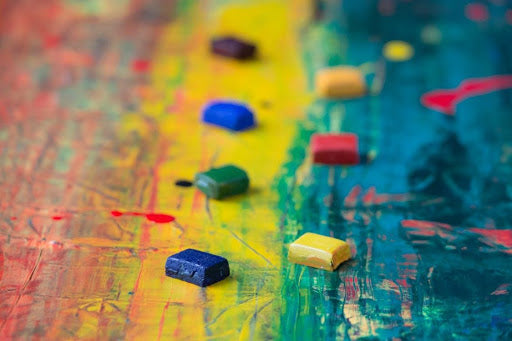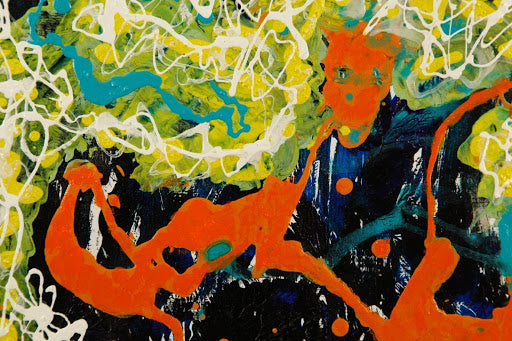The Evolution of Gender Roles in the Abstract Art World 📰

Gender Roles in Abstract Art
The 1950s and the advent of abstract art marked varying socio-economical values compared to the society we live in today. Previous years comprised of gender biases in the fields of politics, economics, education, history, arts, culture, and any other medium you can think of. This affected every aspect of the way the society functioned at large – from one’s daily routine to the responsibilities they held with regards to children, jobs, running the household, etc.
The same nuances were also expressed in the abstract art world. Women and feminine subjects were treated the same way they were considered in the general society. However, the abstract art world added an addition – something far more complex from the pre-defined roles a woman was expected to showcase. Women who were artists had societal expectations to be placed on them and they were required to adhere to the same social requirements, even if male artists took a different approach in their portrayal and expressionism. Moreover, the same women artists were expected to care for their children and households, all while they took their practice forward. However, if they wanted to be taken seriously in the abstract art world, they were required to prioritize their own art – something that was not common with the expectations involved. To describe the situation more, women subjects within abstract expressionism were viewed as negative themes by men and were often used to depict their primary intent of a man’s desires in the painting.
What contributed to the dominant gender roles in the abstract art world?
As mentioned above, the societal roles of gender were influenced in the art world as well. It is important to note that there were several factors that contributed to the bias expressionism with abstract art, mostly contributed by the medium of politics present at that time. Below are some of the factors such an influence was present:
- One of the primary factors was the anti-communist sentiments that settled due to the Cold War in the United States. Every household took up the responsibility to fight the communists' influence seeping into the country. This meant the country’s traditional stay-at-home wife was one of the factors that separated the United States from the Soviets whose women were known to be single and hardworking throughout Eastern European societies.
- One of the second reasons how gender roles were reinforced was the banning and castigation of homosexuality in societies. Men were required and needed to be seen as ‘masculine’ with no feminine qualities whatsoever. As a result, females were considered subservient and automatically influenced by their male counterparts.
- Lastly, notions about traditional family life were influenced soon after World War II. During that time, women received some independence as they were permitted to join their workforce while their husbands fought the war. As soon as WWII ended, the reintegration of society was called where both, men and women, were required to return to their traditional gender roles to form a family life. This meant that males were to be the sole breadwinners of the family, while the women had to take care of the children and household.
How were gender roles depicted in abstract art?
Abstract Expressionism in the 1950s comprised of male-dominated artists who were heavily influenced by Jungian psychology and the writings of Joseph Campbell. The work within the same art field was made such that there was a sense of connection made through a universal storyline – one that included evident gender roles against females in the society. An art critic, Clement Greenberg, attempted to summarize the work of the majority of the male abstract artists, “If the term ‘Abstract Expressionism’ means anything viable, it means painterliness: loose rapid handling, or the look of it; masses that blot or fuse instead of shapes that stay distinct; large, conspicuous rhythms; broken color, uneven saturation, and densities of paint; exhibited brush, knife, finger, or rag marks. The efforts of not only critics, collectors, and gallerists, but to an important degree the artists themselves secured at the basis of value in Abstract Expressionism those characteristics that were also marked as having the highest social value in American society: masculinity, heterosexuality, and whiteness”
On the contrary, there were female artists that were present as well. However, the strict gender roles were so apparent in abstraction that it highly influenced a female artist's role in society. The “Artists Club” of Abstract Expressionists, for example, excluded women purposefully. Lee Krasner, one of the leading female artists in the abstract art world stated, “It’s quite clear that I didn’t fit in, although I never felt I didn’t. I was not accepted, let me by it that way…with relation to the group, if you are going to call them a group, there was no room for a woman.”
Moreover, male artists also disregarded women artists’ work and expressed their approval and disapproval for any piece. A male artist, Hans Hoffmann, commented on one of Lee Krasner’s paintings stating that “This is so good you would not believe it was done by a woman.”
It was not only the artists who imposed gender roles in the abstract art world. Gallerists, critics, and magazines often had a quota system that disregarded paintings made by women artists. In such a case, they would not portray a piece if it was made by a woman and they already had too many women artists on the list.
As mentioned above, the female artists during the 1950’s also lived a dual life. On the one hand, they were required to be efficient wives and mothers to their children. As a result, several female artists did not marry anyone, while others separated from their spouses to avoid such pressure. In order to be considered serious in the abstract art world, female artists made sure caregiving responsibilities did not influence or get in the way of their artistic dreams. As for the women who did marry, they were required to give up their art in order to care for their husbands and children. A woman artist found it impossible to work on both factors simultaneously.

Famous Abstract Art Paintings of Women
No matter the dynamics of society during the advent of abstract art, there were painters – men and women- that had their own unique form of expressionism. Abstract art, as a medium, is about looking at an illustration beyond the surface and allowing your mind to wander based on whatever clicks first. Out of all the subjects, how were women integrated into abstraction in the works of an artist? Were their struggles communicated? Or was it something entirely different? Here are some of the famous abstract paintings of women and the various messages they aim to depict:
Gaea by Lee Krasner
Centuries ago, ancient Greek communities believed that the creator of the universe was a feminine entity named Gaea. She was the one responsible for giving birth to all that existed in the human race, including the other gods and goddesses. In 1966, Lee Krasner painted an illustration of Gaea. The painting holds a unique place in Krasner’s work as it was created just after she had emerged from a very difficult time in her life. The colors, tone, and textures showcase a mix of power, beauty, harmony, and energy all in one painting.
Ma Jolie by Pablo Picasso
Transliterating to “My Pretty Girl,” Picasso painted the picture on the same name the French song was released during the time. An illustration is a Cubist form of abstract art that is merely popular for the lack of subjects present. However, it is still expressive as a painting of a woman. Within the complex structure of the painting, one can identify the female body from the head to the toe. Each body part is illustrated with a dark and light tone in order to highlight the femininity of the painting and express the work in its true light.
Abstraction by Georgia O’Keeffe
Georgia O’Keeffe was popular in immersing herself and her viewers in feelings of a picture. To her, it was beyond what you see with a naked eye in any given painting. Due to this, Keeffe often created large-scale, close-up images in each of her works. One of them used the same concept of abstraction and illustrated a woman sleeping. It was drawn in charcoal and then surpassed over with a brush for a dreamy texture. The image is stoic and placid, yet it depicts tons of emotions about the woman subject.
Woman with Pails by Kazimir Malevich
One of the most popular abstract artists, Kazimir Malevich created his own medium of abstraction – Suprematism. This new form was devoted to the rejection of subject matter and integration of universalities. Women with Pails painting speaks towards the traditional gender roles in Russia during the time the masterpiece was created. Targeting the working class specifically, the subject is seen to communicate in a utopian way through the responsibilities surrounding her.
Woman with Three Hairs Surrounded by Birds by Joan Miró
Not entirely an abstract artist, Joan Miro delved into a combination of iconography, reduced forms, and a limited color pallet. He often explored the subjects of women and children in his work, including the painting of Woman with Three Hairs. In this, he showcased a lone woman subject portraying strength and balance. Despite its complex and strange drawing, the picture meditative in all its forms.
Woman I by Willem De Kooning
A controversial, but a popular figure in the world of abstraction, William De Kooning works on energetic paintings with a myriad of expressionism involved. In one of his most famous paintings of women subjects, evidence on the intent of male artists when painting female subjects is noticed. It depicts an abstract image of a woman and speaks about the subjects of objectification and intent as a whole.
Breakfast with an Ear by Maria Lassnig
Maria Lassnig is an Australian artist who stands out for her abstract female portraits in the contemporary world. Through almost all her works in the subjects, Lassnig suggests that her primary purpose is to open up broader conversations on body consciousness. Her painting Breakfast with an Ear is one such example where she painted one body part that she was dominantly aware of during that time. The image showcases the larger conversation on preconceived gender roles, as the picture further portrays various kitchen appliances for the same subject.
Tableau by Carrie Moyer
Carrie Moyer is another contemporary abstract artist who uses digital forms of expressionism. Her work engages in social activism and direct commentary on issues surrounding gender stereotypes and gender roles. Tableau, although not directly in its portrayal, is a work that is unique in its mysteriousness. It has a combination of primitive life and a futuristic element, showcasing hope and change for the gender issues present.
As the number of artists who depict women-subjects continue to rise, it is important to look beyond their visual imagery and understand what the true intent and message behind the artist was to begin with.
Conclusion
Gender roles in the abstract art world continue to be showcased in one way or the other. Even if the 1950’s apparent influence has now disappeared, female subjects are still painted in order to portray some sort of objectification, dominance, and subconscious intent. It is only with more female influence and an overall understanding of gender roles that will help such depictions decline.












